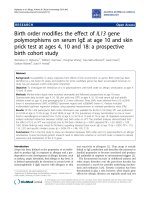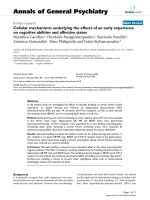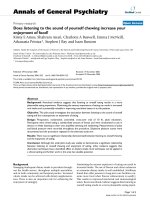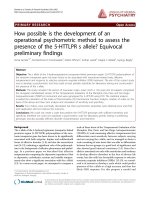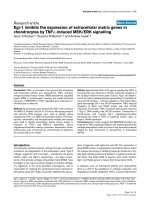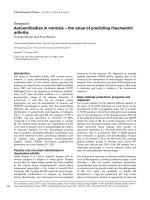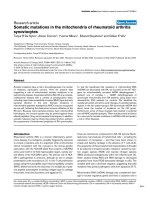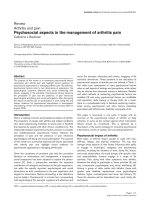Báo cáo y học: "Do we use the appropriate controls for the identification of informative methylation markers for early cancer detection" doc
Bạn đang xem bản rút gọn của tài liệu. Xem và tải ngay bản đầy đủ của tài liệu tại đây (82.75 KB, 3 trang )
Genome
BBiioollooggyy
2008,
99::
405
Correspondence
DDoo wwee uussee tthhee aapppprroopprriiaattee ccoonnttrroollss ffoorr tthhee iiddeennttiiffiiccaattiioonn ooff iinnffoorrmmaattiivvee
mmeetthhyyllaattiioonn mmaarrkkeerrss ffoorr eeaarrllyy ccaanncceerr ddeetteeccttiioonn??
Yasser Riazalhosseini and Jörg D Hoheisel
Address: Functional Genome Analysis, Deutsches Krebsforschungszentrum, Im Neuenheimer Feld 580, 69120 Heidelberg, Germany.
Correspondence: Yasser Riazalhosseini. Email:
Published: 26 November 2008
Genome
BBiioollooggyy
2008,
99::
405 (doi:10.1186/gb-2008-9-11-405)
The electronic version of this article is the complete one and can be
found online at />© 2008 BioMed Central Ltd
Epigenetic programming - the variation
of the chemical modifications of both
histones and DNA - dictates the inter-
pretation of the genetic code. For
example, different cell types can be
distinguished by their, at least partly,
distinct epigenetic status. Similarly,
tumor cells exhibit epigenetic patterns
that vary from those of normal cells.
These differences in epigenetic pro-
gramming cause concomitant differ-
ences in gene-expression patterns.
DNA methylation is the best-studied
epigenetic marker. In the human genome,
DNA methylation occurs at cytosines
that are located 5’ to guanines, known
as CpG dinucleotides. Abnormal changes
in methylation patterns found in human
cancers include global demethylation of
DNA with simultaneous hypermethyla-
tion of CpG-rich regions called CpG
islands. These islands occur in promo-
ter regions of many tumor suppressor
genes and are usually not methylated in
normal cells [1,2]. Because aberrant
DNA-methylation events are both
stable and abundant in tumors and also
occur in the early stages of tumori-
genesis, detection of hypermethylated
DNA is considered a most promising
tool for the diagnosis of cancer. Special-
ized microarrays, mass spectrometry
and - more recently - ultrahigh-through-
put sequencing procedures provide an
opportunity for comprehensive DNA-
methylation profiling of human cancers
with the eventual aim of identifying selec-
tive markers for early detection [3,4].
Including appropriate control (cancer-
free) samples in the analysis is essential
for the identification of true markers. In
solid tumors, cancer-free tissue found
adjacent to the actual tumor, as well as
normal tissues of the same tissue type
from healthy individuals, are conceiv-
able controls. The former are extensively
used as controls in many laboratories
for the exclusion of methylation patterns
induced by factors such as environmen-
tal influences or aging (see for example
[5-7]). The logic of this is based on the
assumption that cancer-associated
methylation alterations would not have
occurred in the adjacent, apparently
normal tissue. However, this assump-
tion has been challenged by recent
reports that identify altered DNA
methylation in preneoplastic lesions
associated with different tumor types,
including breast cancers [8-10].
Examining normal breast cells from
healthy individuals and cells from
breast tumors, Yan et al. [10] found
hypermethylated loci in breast tumors
that showed no or low methylation in
normal individuals. Notably, these loci
were also frequently hypermethylated
in normal tissues adjacent to the
tumors. Hypermethylation of tumor
suppressor genes has also been
reported in women who are at risk of
developing breast cancer but who do
not have cancer. This abnormal change
occurs more frequently in benign breast
epithelium (that is, epithelium with
non-malignant changes) of women at
high risk for breast cancer than in
people at low risk [8,11]. Strikingly,
abnormally methylated DNA has even
been identified in mammary epithelial
cells with normal morphology in high-
risk women [12]. Moreover, a possible
seminal role for epigenetic abnor-
malities in the earliest steps of cancer
initiation has been emphasized [13,14].
In combination, these findings suggest
a possible cancer-predisposing role for
DNA methylation and support the
emerging evidence for an involvement
of aberrant DNA-methylation patterns
AAbbssttrraacctt
It is possible to miss potential DNA methylation markers of tumorigenesis because of the initial
filtering of profiling results on the basis of inappropriate controls.
in the proposed ‘field defect’ (or ‘field
cancerization’) concept [15-17]. It is be-
coming clear that hypermethylation of
DNA in normal-appearing tissue located
adjacent to tumors is more prevalent
than previously recognized. Early cancer-
associated methylation patterns might
also have occurred in these tissues.
Therefore, the epigenetic pattern would
not be distinguishable between cancer
samples and such a control (Figure 1).
In consequence, using patient-matched
normal tissues from regions adjacent to
the actual tumor as the sole control is
probably insufficient for the identifi-
cation and selection of methylation
markers for early cancer detection,
although these control samples could be
helpful in finding prognostic or predic-
tive biomarkers.
A practical example of such an early
alteration is hypermethylation of the
gene SFN in breast cancer. While this
gene is hypermethylated in breast
tumors and adjacent normal tissues, the
breast epithelium from cancer-free
individuals contains unmethylated SFN
DNA. However, SFN methylation was
not identified as a potential marker in a
recent comprehensive genome-wide
methylation analysis, because the initial
filtering was referenced only to the
tissues adjacent to the tumors in cancer
patients [6,18,19]. One cannot entirely
exclude the possibility that factors
related to the array-analysis platform,
such as assay sensitivity, might have
contributed to the result. This is very
unlikely, however.
DNA-methylation patterns associated
with cancer development have been
recognized for their potential in clinical
use. They are under study as diagnostic
markers, prognostic factors and predic-
tors of responses to treatment. In
addition, a human epigenome project
has been launched to map all epigenetic
patterns in normal and affected cells
[2,3,20]. The methods and processes
are at hand for specific and sensitive
screening approaches to aid DNA
marker identification. In this Corres-
pondence, we picked breast cancer for
in-depth discussion. However, the
points raised are likely to be valid for
other types of tumors. For all these, the
addition of appropriate cancer-free
control materials to the screening panels
might help in the identification of truly
informative markers and would avoid
missing DNA-methylation markers for
early detection and risk assessment.
RReeffeerreenncceess
1. Jones PA, Baylin SB:
TThhee eeppiiggeennoommiiccss ooff
ccaanncceerr
Cell
2007,
112288::
683-692.
2. Esteller M:
EEppiiggeenneettiiccss iinn ccaanncceerr
N Engl J
Med
2008,
335588::
1148-1159.
3. Gal-Yam EN, Saito Y, Egger G, Jones PA:
CCaanncceerr eeppiiggeenneettiiccss:: mmooddiiffiiccaattiioonnss,, ssccrreeeenn
iinngg,, aanndd tthheerraappyy
Annu Rev Med
2008,
5599::
267-280.
4. Hoheisel JD:
MMiiccrrooaarrrraayy tteecchhnnoollooggyy::
bbeeyyoonndd ttrraannssccrriipptt pprrooffiilliinngg aanndd ggeennoottyyppee
aannaallyyssiiss
Nat Rev Genet
2006,
77::
200-210.
5. Shames DS, Girard L, Gao B, Sato M, Lewis
CM, Shivapurkar N, Jiang A, Perou CM,
Kim YH, Pollack JR, Fong KM, Lam CL,
Wong M, Shyr Y, Nanda R, Olopade OI,
Gerald W, Euhus DM, Shay JW, Gazdar AF,
Minna JD:
AA ggeennoommee wwiiddee ssccrreeeenn ffoorr pprroo
mmootteerr mmeetthhyyllaattiioonn iinn lluunngg ccaanncceerr iiddeennttiiffiieess
nnoovveell mmeetthhyyllaattiioonn mmaarrkkeerrss ffoorr mmuullttiippllee
mmaalliiggnnaanncciieess
PLoS Med
2006,
33::
e486.
6. Ordway JM, Budiman MA, Korshunova Y,
Maloney RK, Bedell JA, Citek RW, Bacher
B, Peterson S, Rohlfing T, Hall J, Brown R,
Lakey N, Doerge RW, Martienssen RA,
Leon J, McPherson JD, Jeddeloh JA:
IIddeennttiiffii
ccaattiioonn ooff nnoovveell hhiigghh ffrreeqquueennccyy DDNNAA
mmeetthhyyllaattiioonn cchhaannggeess iinn bbrreeaasstt ccaanncceerr
PLoS
ONE
2007,
22::
e1314.
7. Chung W, Kwabi-Addo B, Ittmann M,
Jelinek J, Shen L, Yu Y, Issa JP:
IIddeennttiiffiiccaattiioonn
ooff nnoovveell ttuummoorr mmaarrkkeerrss iinn pprroossttaattee,, ccoolloonn
aanndd bbrreeaasstt ccaanncceerr bbyy uunnbbiiaasseedd mmeetthhyyllaattiioonn
pprrooffiilliinngg
PLoS ONE
2008,
33::
e2079.
8. Lewis CM, Cler LR, Bu DW, Zochbauer-
Muller S, Milchgrub S, Naftalis EZ, Leitch
AM, Minna JD, Euhus DM:
PPrroommootteerr hhyyppeerr
mmeetthhyyllaattiioonn iinn bbeenniiggnn bbrreeaasstt eeppiitthheelliiuumm iinn
rreellaattiioonn ttoo pprreeddiicctteedd bbrreeaasstt ccaanncceerr rriisskk
Clin Cancer Res
2005,
1111::
166-172.
9. Holst CR, Nuovo GJ, Esteller M, Chew K,
Baylin SB, Herman JG, Tlsty TD:
MMeetthhyyllaa
ttiioonn ooff pp1166((IINNKK44aa)) pprroommootteerrss ooccccuurrss iinn
vviivvoo iinn hhiissttoollooggiiccaallllyy nnoorrmmaall hhuummaann
mmaammmmaarryy eeppiitthheelliiaa
Cancer Res
2003,
6633::
1596-1601.
10. Yan PS, Venkataramu C, Ibrahim A, Liu JC,
Shen RZ, Diaz NM, Centeno B, Weber F,
Leu YW, Shapiro CL, Eng C, Yeatman TJ,
Huang TH:
MMaappppiinngg ggeeooggrraapphhiicc zzoonneess ooff
ccaanncceerr rriisskk wwiitthh eeppiiggeenneettiicc bbiioommaarrkkeerrss iinn
nnoorrmmaall bbrreeaasstt ttiissssuuee
Clin Cancer Res
2006,
1122::
6626-6636.
11. Euhus DM, Bu D, Milchgrub S, Xie XJ, Bian
A, Leitch AM, Lewis CM:
DDNNAA mmeetthhyyllaattiioonn
iinn bbeenniiggnn bbrreeaasstt eeppiitthheelliiuumm iinn rreellaattiioonn ttoo
aaggee aanndd bbrreeaasstt ccaanncceerr rriisskk
Cancer Epi-
demiol Biomarkers Prev
2008,
1177::
1051-
1059.
12. Bean GR, Bryson AD, Pilie PG, Goldenberg
V, Baker JC Jr, Ibarra C, Brander DM, Paisie
C, Case NR, Gauthier M, Reynolds PA,
Dietze E, Ostrander J, Scott V, Wilke LG,
Yee L, Kimler BF, Fabian CJ, Zalles CM,
Broadwater G, Tlsty TD, Seewaldt VL:
MMoorrpphhoollooggiiccaallllyy nnoorrmmaall aappppeeaarriinngg
mmaammmmaarryy eeppiitthheelliiaall cceellllss oobbttaaiinneedd ffrroomm
hhiigghh rriisskk wwoommeenn eexxhhiibbiitt mmeetthhyyllaattiioonn ssiilleenncc
iinngg ooff IINNKK44aa//AARRFF
Clin Cancer Res
2007,
1133::
6834-6841.
13. Baylin SB, Ohm JE:
EEppiiggeenneettiicc ggeennee ssiilleenncciinngg
iinn ccaanncceerr aa mmeecchhaanniissmm ffoorr eeaarrllyy oonnccoo
ggeenniicc ppaatthhwwaayy aaddddiiccttiioonn??
Nat Rev Cancer
2006,
66::
107-116.
14. Feinberg AP, Ohlsson R, Henikoff S:
TThhee
eeppiiggeenneettiicc pprrooggeenniittoorr oorriiggiinn ooff hhuummaann
ccaanncceerr
Nat Rev Genet
2006,
77::
21-33.
15. Giovannucci E, Ogino S:
DDNNAA mmeetthhyyllaattiioonn,,
ffiieelldd eeffffeeccttss,, aanndd ccoolloorreeccttaall ccaanncceerr
J Natl
Cancer Inst
2005,
9977::
1317-1319.
16. Shen L, Kondo Y, Rosner GL, Xiao L, Her-
nandez NS, Vilaythong J, Houlihan PS,
/>Genome
BBiioollooggyy
2008, Volume 9, Issue 11, Article 405 Riazalhosseini and Hoheisel 405.2
Genome
BBiioollooggyy
2008,
99::
405
FFiigguurree 11
Schematic presentation of the possible variations in the DNA methylation status of a genomic locus
and the conclusions that could be drawn from this information. Plus and minus signs indicate hyper-
and hypomethylation, respectively.
Adjacent
normal
tissue
Tumour
tissue
+-
Cancer
detection
Normal
tissue
from
healthy
individual
Early detection
risk assessment
Tissue-specific
pattern
+
+
?
+
-
Krouse RS, Prasad AR, Einspahr JG, Buck-
meier J, Alberts DS, Hamilton SR, Issa JP:
MMGGMMTT pprroommootteerr mmeetthhyyllaattiioonn aanndd ffiieelldd
ddeeffeecctt iinn ssppoorraaddiicc ccoolloorreeccttaall ccaanncceerr
J Natl
Cancer Inst
2005,
9977::
1330-1338.
17. Liang G, Wolff EM, Chihara Y, Pan F,
Weisenberger D, Laird PW, Jones PA:
DDNNAA mmeetthhyyllaattiioonn pprrooffiillee ooff 11550011 llooccii iinn
bbllaaddddeerr ccaanncceerr sshhoowwss eevviiddeennccee ooff aa ffiieelldd
ddeeffeecctt
In
Proc 99th Annual Meeting Am
Ass Cancer Res: 12-16 April 2008; San
Diego
. 2008: Abstract 2625.
18. Ferguson AT, Evron E, Umbricht CB,
Pandita TK, Chan TA, Hermeking H, Marks
JR, Lambers AR, Futreal PA, Stampfer MR,
Sukumar S:
HHiigghh ffrreeqquueennccyy ooff hhyyppeerrmmeetthhyy
llaattiioonn aatt tthhee 1144 33 33 ssiiggmmaa llooccuuss lleeaaddss ttoo
ggeennee ssiilleenncciinngg iinn bbrreeaasstt ccaanncceerr
Proc Natl
Acad Sci USA
2000,
9977::
6049-6054.
19. Umbricht CB, Evron E, Gabrielson E, Fer-
guson A, Marks J, Sukumar S:
HHyyppeerrmmeetthhyy
llaattiioonn ooff 1144 33 33 ssiiggmmaa ((ssttrraattiiffiinn)) iiss aann eeaarrllyy
eevveenntt iinn bbrreeaasstt ccaanncceerr
Oncogene
2001,
2200::
3348-3353.
20. Jones PA, Martienssen R:
AA bblluueepprriinntt ffoorr aa
hhuummaann eeppiiggeennoommee pprroojjeecctt:: tthhee AAAACCRR
HHuummaann EEppiiggeennoommee WWoorrkksshhoopp
Cancer Res
2005,
6655::
11241-11246.
/>Genome
BBiioollooggyy
2008, Volume 9, Issue 11, Article 405 Riazalhosseini and Hoheisel 405.3
Genome
BBiioollooggyy
2008,
99::
405

